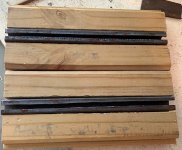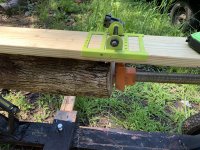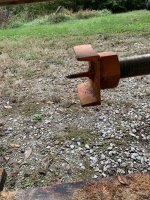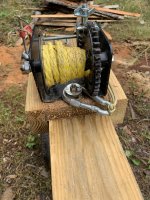I got the lumber mill bug about a year ago. To start simple (& cheap), my son-in-law dropped off his Timber-tuf Sawmill attachment. My first attempts on some hard Maple came out very rough. Then I ran across some used 1 3/4" all-thread threaded rod in random lengths of 45-48" long and nuts to go with them at a cheap price ($20 bucks). I had some 6" C-channel left over from a previous project. I came up with a design consisting of two uprights about 9ft apart. I drilled 2" holes in each end and welded on two nuts on each end spaced so that the all-thread would thread through them. On the ends of the all-thread, i threaded on a nut with a small plate and lag bolted welded on -- to form the spindles on both ends. I created end blocks for the 2x6 guide board to sit it. Tracks in the end blocks allow carriage bolts to slide back and forth to control the depth of cut. I attached a scissor jack from a junk car in the middle to raise the log up to the spindles. After a few trial passes, I add a boat winch on a track. I operate this thing by standing along side the log, with my left hand on the saw throttle and my right hand on my battery drill turning the worm gear on the winch which retracts the rope toward the end and pulls the saw along the guide board. This results in a very steady rate of travel and a smooth cut.

Here are a few pics:
 (Guide blocks with track cut into 1" tubing)
(Guide blocks with track cut into 1" tubing) Timber_tuf jig sitting on board board.
Timber_tuf jig sitting on board board.



The grey winch in the large picture is not used -- there's no gear down and would not be easy to operate smoothly. I'll remove it (someday).
The cherry 6x6's (give or take) -- look pretty good. No final plans what to do with them, but it seemed a shame to cut them up into firewood.
I normally do not have the wheels attached -- the base sits flat on the ground. I slide in some 2x4'x as cross members to stabilize it from side-to-side. I recently purchased an Oregon Rip chain which improved the easy of cutting; however it didn't stay sharp very long. Early on, I opted to drill 2 holes (3/16") in my bar and bolt the Timber-tuf to my bar rather than rely on friction. I ruined one chain when the bar slipped and the chain engaged the yoke. However, that means it takes longer to remove the 2 bolts, in order to remove the chain to sharpen it on my bench grinder.
All in all -- I'm happy with the outcome. I'm still learning a lot about wood and how to mill it into lumber.
Here are a few pics:
 (Guide blocks with track cut into 1" tubing)
(Guide blocks with track cut into 1" tubing) Timber_tuf jig sitting on board board.
Timber_tuf jig sitting on board board.

The grey winch in the large picture is not used -- there's no gear down and would not be easy to operate smoothly. I'll remove it (someday).
The cherry 6x6's (give or take) -- look pretty good. No final plans what to do with them, but it seemed a shame to cut them up into firewood.
I normally do not have the wheels attached -- the base sits flat on the ground. I slide in some 2x4'x as cross members to stabilize it from side-to-side. I recently purchased an Oregon Rip chain which improved the easy of cutting; however it didn't stay sharp very long. Early on, I opted to drill 2 holes (3/16") in my bar and bolt the Timber-tuf to my bar rather than rely on friction. I ruined one chain when the bar slipped and the chain engaged the yoke. However, that means it takes longer to remove the 2 bolts, in order to remove the chain to sharpen it on my bench grinder.
All in all -- I'm happy with the outcome. I'm still learning a lot about wood and how to mill it into lumber.